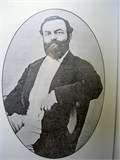Charles Augustus Lafayette Lamar
| Charles Augustus Lafayette Lamar | |
|---|---|
|
Formal seated portrait | |
| Born |
August 1, 1824 Savannah, Georgia |
| Died |
April 16, 1865 Columbus, Georgia |
Charles Augustus Lafayette Lamar (1824-1865) the son of Gazaway Bugg Lamar was born and raised in Savannah, Georgia. His mother and all 6 of his siblings were lost in the shipwreck of the steamship Pulaski. Prior to the start of the Civil War he invested in the Wanderer which had run the slave blockade and was later impounded. During the war he was active with his father in the Importing and Exporting Company of Georgia, one of the blockade runners of the American Civil War. Toward the end of the war he held the rank of Colonel, and according to U.S. General William Tecumseh Sherman, was the last Confederate killed in the Civil War,[1] at the Battle of Columbus (1865).
Career
Born in Savannah, his mother was Jane Meek Creswell also of Savannah. "Contemporaries described Charles, born April 1, 1824, as a large, red-headed man, and his outspoken manners earned him the descriptive title of "fire-brand".[2] His second middle name came about because the Marquis de Lafayette was present at his baptism as is stated in the record of the church. Lafayette, however is not his godfather as is often mistakenly reported. After the senior Lamar moved to New York in 1846, Charles was appointed to look after his father's extensive business activities in Savannah. By 1857, Charles led a group of investors in the purchase of the Wanderer and had it outfitted with large water tanks and other tools of the now illegal slave trade.[3] In November 1858 the ship crossed the Atlantic and unloaded a large group of slaves.[4] Because of their filed teeth and unique tattoos, these new slaves, known as "greenies" were evidence that a boat had recently run the blockade. On December 16, 1858 a resolution was passed in the U. S. Senate asking the President share any information "in relation to the landing of the barque Wanderer on the coast of Georgia with a load of Africans." the Wanderer was seized and the matter ended up in Federal court on May 28, 1860. The federal judge found no link between Charles A. L. Lamar and the Wanderer. The U. S. district judge, John Nicoll was Lamar's father-in-law.[5] His father was not in support of Charles' activities as is shown in a letter the father wrote to John B. Lamar on October 16, 1858 which stated "I am not on Charley's side in the controversy...but he is so impulsive & so crazy on that Negro question-that I can make no impression on him." After the start of the Civil War, Charles was one of the organizers of and became a Lieutenant Colonel of the 7th Georgia Battalion. When the 7th merged with the 61st Georgia Volunteer Infantry, Charles was thrown out by what he considered unjust treatment. From then on until late in the war, he worked with his father in his blockade running ventures.[6] Charles was sent to England to attempt to buy boats for the gun running venture where he worked and travelled with the famous ship captain John Newland Maffitt.
As the war was winding down, Charles went back into the Confederate army as a Colonel on the staff of General Howell Cobb where he was shot and killed in what is considered to be the last battle of the Civil War at Columbus, Georgia, while attempting to lead a charge against Union troops, seven days after Appomattox. The Savannah Morning News wrote that he was "the last man who fell in organized struggle for Southern independence." He was buried at Linwood Cemetery (Columbus, Georgia), but a year later interred at Laurel Grove.
References
- ↑ Sherman to West
- ↑ Thomas Lamar Coughlin, "Those Southern Lamars" ISBN 0-7388-2410-0
- ↑ Tom Henderson Wells, "The Slave Ship Wanderer", University of Georgia Press, 1967
- ↑ Tom Henderson Wells, "Charles Augustus Lafayette Lamar: Gentleman Slave Trader", The Georgia Historical Quarterly, Vol. 47, No. 2 (June, 1963), pp. 158-168
- ↑ Thomas Lamar Coughlin, "Those Southern Lamars" ISBN 0-7388-2410-0
- ↑ Thomas Lamar Coughlin, "Those Southern Lamars" ISBN 0-7388-2410-0
See also
- Thomas Robson Hay, "Gazaway Bugg Lamar, Confederate Banker and Business Man", The Georgia Historical Quarterly Vol. 37, No. 2 (June, 1953), pp. 89–128
- Georgia Historical Society "Charles Augustus Lafayette Lamar and the Movement to Reopen the African Slave Trade", James Jordan
External links
- Find a Grave http://www.findagrave.com/cgi-bin/fg.cgi?page=gr&GRid=19983653
- G. B. Lamar papers in library Univ. of Georgia http://hmfa.libs.uga.edu/hmfa/view?docId=ead/ms10-ead.xml;query=;brand=default
- C. A. L. papers Emory Univ. http://findingaids.library.emory.edu/documents/lamar400/#descriptive_summary
- Savannah Morning News 150th article: http://savannahnow.com/features/150years/week32/
- New York Times 1859 article: http://query.nytimes.com/mem/archive-free/pdf?res=FB0815FE3D541B7493C7AB178BD95F4D8584F9
